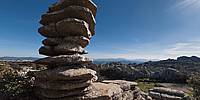
The Modeling Karst
El Tornillo del Torcal, Antequera, Spain
15 March 2013, 16:35 local time
© 2013 Miguel Sepúlveda, All Rights Reserved.
250 million years ago, began to be formed these rocks types oolitic limestones, breccia and clastic sediments with accumulation of marine origin, during the Jurassic in the Mesozoic Era.
33 million years ago, during the Alpine Orogeny tectonic forces pushed these marine sediments and elevated more than 1000 meters above the sea level. Oligocene Epoch of the Cenozoic Era.
During later epochs was fracturing the rock creating cracks and fault systems. The erosion caused by the effect of acid atmospheric CO2 carbon dioxide present in the water from rain, frost wedging and the clash of particles in the wind, were modeled sediment layers.
23 million years ago the first simians appear. 20 million years after Homo habilis appears and develop anatomically modern humans.
1 million years ago passed through here from the African Comtinente the first hominids to settle in Europe.
10,000 years ago BC, lived here the last Homo Neanderthalensis.
5000 years BC in the Neolithic to the Copper Age 3000 BC this land was occupied by Homo Sapiens.
2500 years B.C. first wheels were constructed for transport. In 1885 it created the first automobile with internal combustion engine with gasoline. Today the car who brought me here, has four wheels, diesel engine and satellite navigation system.
500 years ago, Leonardo Da Vinci about development projects flying machines. In 1903, the Wright brothers for the first time they fly an airplane controlled. Now while I'm doing these photographs, I see across the sky, these machines of Leonardo's dreams
In 1836 it presented to the world the first daguerreotype, which permitted to keep an image captured with a dark chamber. 177 years after the photograph is in the digital age and allows me to capture images and preserve them to instantly.
In 1971, the Intel company, manufactures a microprocessor called 4004. The 4004 was the world's first microprocessor. It was a 4-bit CPU and was first available commercially. Today computers have powerful CPU, with them we can process the images, stitching them and send around the world.
And all this technology will be outdated soon, and the future will surprise us with new progress.
However after taking the pictures, I noticed one thing: In the eighth substrate layer from the top of this formation called El Tornillo ( the Screw ), I see a piece missing and I remember the last time I was here there was no such deterioration, which leads me to the final conclusion that what nature has employed millions of years to create, the humans are able to destroy it in seconds.
Lat: 36° 57' 19.14" N
Long: 5° 33' 24.16" W
Elevation: 1220 m.
Precision is: High. Pinpoints the exact spot.


 Tap or click the zoom icon in the bottom right corner of the picture to switch between in-page and fullscreen view
Tap or click the zoom icon in the bottom right corner of the picture to switch between in-page and fullscreen view